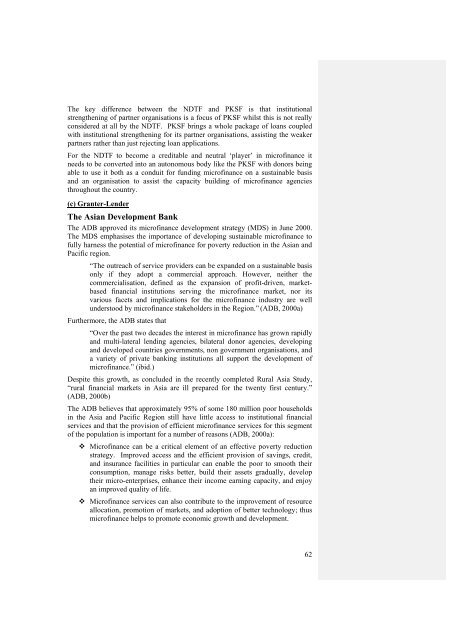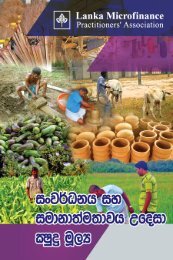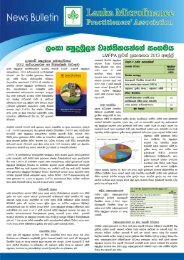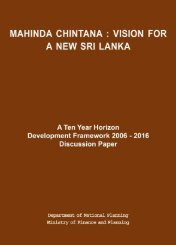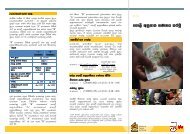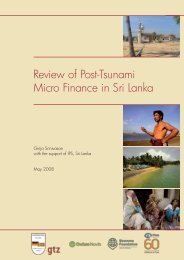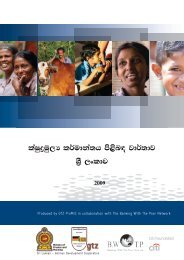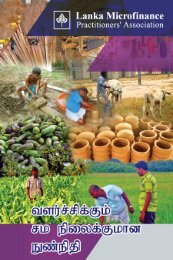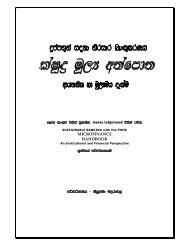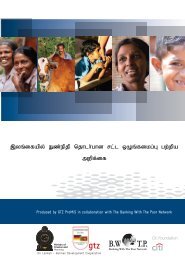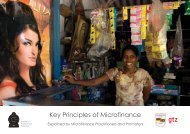National Microfinance Study of Sri Lanka: Survey of Practices and ...
National Microfinance Study of Sri Lanka: Survey of Practices and ...
National Microfinance Study of Sri Lanka: Survey of Practices and ...
Create successful ePaper yourself
Turn your PDF publications into a flip-book with our unique Google optimized e-Paper software.
The key difference between the NDTF <strong>and</strong> PKSF is that institutional<br />
strengthening <strong>of</strong> partner organisations is a focus <strong>of</strong> PKSF whilst this is not really<br />
considered at all by the NDTF. PKSF brings a whole package <strong>of</strong> loans coupled<br />
with institutional strengthening for its partner organisations, assisting the weaker<br />
partners rather than just rejecting loan applications.<br />
For the NDTF to become a creditable <strong>and</strong> neutral ‘player’ in micr<strong>of</strong>inance it<br />
needs to be converted into an autonomous body like the PKSF with donors being<br />
able to use it both as a conduit for funding micr<strong>of</strong>inance on a sustainable basis<br />
<strong>and</strong> an organisation to assist the capacity building <strong>of</strong> micr<strong>of</strong>inance agencies<br />
throughout the country.<br />
(c) Granter-Lender<br />
The Asian Development Bank<br />
The ADB approved its micr<strong>of</strong>inance development strategy (MDS) in June 2000.<br />
The MDS emphasises the importance <strong>of</strong> developing sustainable micr<strong>of</strong>inance to<br />
fully harness the potential <strong>of</strong> micr<strong>of</strong>inance for poverty reduction in the Asian <strong>and</strong><br />
Pacific region.<br />
“The outreach <strong>of</strong> service providers can be exp<strong>and</strong>ed on a sustainable basis<br />
only if they adopt a commercial approach. However, neither the<br />
commercialisation, defined as the expansion <strong>of</strong> pr<strong>of</strong>it-driven, marketbased<br />
financial institutions serving the micr<strong>of</strong>inance market, nor its<br />
various facets <strong>and</strong> implications for the micr<strong>of</strong>inance industry are well<br />
understood by micr<strong>of</strong>inance stakeholders in the Region.” (ADB, 2000a)<br />
Furthermore, the ADB states that<br />
“Over the past two decades the interest in micr<strong>of</strong>inance has grown rapidly<br />
<strong>and</strong> multi-lateral lending agencies, bilateral donor agencies, developing<br />
<strong>and</strong> developed countries governments, non government organisations, <strong>and</strong><br />
a variety <strong>of</strong> private banking institutions all support the development <strong>of</strong><br />
micr<strong>of</strong>inance.” (ibid.)<br />
Despite this growth, as concluded in the recently completed Rural Asia <strong>Study</strong>,<br />
“rural financial markets in Asia are ill prepared for the twenty first century.”<br />
(ADB, 2000b)<br />
The ADB believes that approximately 95% <strong>of</strong> some 180 million poor households<br />
in the Asia <strong>and</strong> Pacific Region still have little access to institutional financial<br />
services <strong>and</strong> that the provision <strong>of</strong> efficient micr<strong>of</strong>inance services for this segment<br />
<strong>of</strong> the population is important for a number <strong>of</strong> reasons (ADB, 2000a):<br />
<strong>Micr<strong>of</strong>inance</strong> can be a critical element <strong>of</strong> an effective poverty reduction<br />
strategy. Improved access <strong>and</strong> the efficient provision <strong>of</strong> savings, credit,<br />
<strong>and</strong> insurance facilities in particular can enable the poor to smooth their<br />
consumption, manage risks better, build their assets gradually, develop<br />
their micro-enterprises, enhance their income earning capacity, <strong>and</strong> enjoy<br />
an improved quality <strong>of</strong> life.<br />
<strong>Micr<strong>of</strong>inance</strong> services can also contribute to the improvement <strong>of</strong> resource<br />
allocation, promotion <strong>of</strong> markets, <strong>and</strong> adoption <strong>of</strong> better technology; thus<br />
micr<strong>of</strong>inance helps to promote economic growth <strong>and</strong> development.<br />
62


